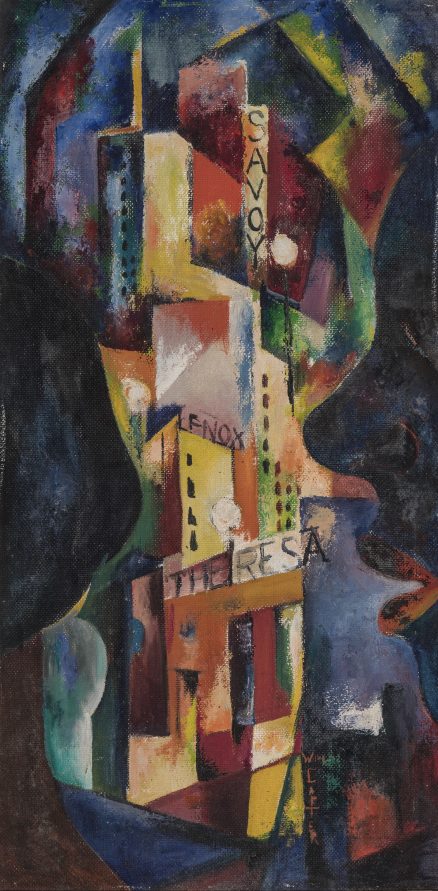- Categories
- African American artists
- Landscapes
- Zoom in on Artwork
- Print Page
- Email Page to Friend
Verging on an abstract composition, William S. Carter’s Savoy presents the forms of tall modern urban buildings fractured into planes of bright color. Glowing with nighttime illumination, they create an enticing spectacle contemplated by an approaching couple whose heads frame the view. At the right, a man in profile turns to speak to his companion, a woman seen only from behind. The buildings are emblazoned with signs reading “Savoy,” “Lenox,” and “Theresa”—names that evoke the New York City neighborhood of Harlem. From the 1910s through the 1930s, it was a black cultural mecca renowned for its entertainment, especially jazz music and popular dance, which appealed equally to blacks and whites. One of Harlem’s most important performance venues was the Savoy Ballroom: opened in 1926 on Lenox Avenue between 140th and 141st Streets, it was soon touted as the world’s finest ballroom. The high-rise Hotel Theresa on Seventh Avenue (today’s Adam Clayton Powell Jr. Boulevard) was a whites-only luxury establishment that became a vibrant center of African American life after it was desegregated in 1940.
Carter probably painted Savoy shortly after returning home from his only recorded visit to New York, in 1941. During his brief stay there, this jazz and dance aficionado likely attended performances at the famed Savoy. He also toured art galleries, and at the Downtown Gallery he was invited to contribute a work to the “American Negro Art” exhibition, a benefit for a fund for African American artists, which opened in early December. As Carter later recalled, he quickly purchased materials and set about making a painting to show.i Hung alongside paintings by such luminaries as Henry Ossawa Tanner and Archibald J. Motley Jr., Carter’s Purple Plum was among those “of especial merit” in the display, in the view of New York Times art critic Edward Alden Jewell.ii
Savoy demonstrates the influence of Cubism. Throughout his career, Carter both experimented with modernist distortion and worked in a solidly representational manner. This image is less a picture of the city as Carter saw it than a montage of its famous place-names and soaring skyline that captures the excitement of New York and of Harlem for the struggling Carter. The name Savoy equally evokes the artist’s hometown, however. The year after Harlem’s Savoy Ballroom opened, its equally lavish namesake opened in the Bronzeville neighborhood on Chicago’s South Side. It too quickly became a prominent destination for jazz performances, public dances, sports matches, and other entertainments, as well as community meetings, and Carter attended many events there. Moreover, beginning in 1939, Chicago’s Savoy Ballroom hosted many of the Artists and Models Balls staged to benefit the South Side Community Art Center, which opened in 1940 and played an important role in the development of Carter’s artistic career. He was among a host of African American artists who designed sets, costumes, and decorations for the balls.
Wendy Greenhouse, PhD
Donated by M. Christine Schwartz to the Krannert Art Museum, University of Illinois Urbana-Champaign, Champaign, Illinois, in 2023
i William Carter, interview by Toni Costonie, Nov. 3, 1988, transcript, 98-99, African-American Artists in Chicago Oral History Program, Archives of American Art, Smithsonian Institution.
ii Edward Alden Jewell, “Negro Art Display Put on Exhibition,” New York Times, Dec. 10, 1941.
